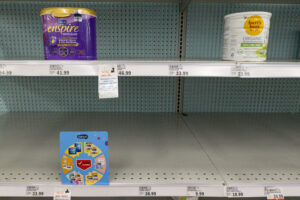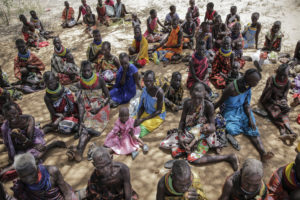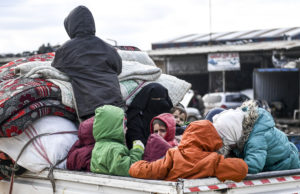Kids’ Questions on a Lockdown Planet
I just couldn’t square my son’s loving exuberance and confidence in the people around him with the sheer, teeth-hurting terror of children being stalked by an armed killer through the halls of the Friendship School. How, after all, do you practice for the unthinkable? Susana Fernandez / CC BY-ND 2.0
1
2
3
Susana Fernandez / CC BY-ND 2.0
1
2
3
Why? Why? Why? As a kid, I got an earful every time I asked that question. My parents were comfortable exposing my brother, sister, and me to the horrors of our world. In first or second grade, my activist parents involved me in a UNICEF slide show about world hunger. We would go to churches and schools where I would recite the script, full of sad (and still, sadly, largely on the mark) statistics about how children throughout the world suffer from malnutrition. I could tell you why kids were hungry all over the world, since my mom had tacked on a conclusion to the slide show that lay the blame squarely on the U.S. military-industrial complex.
My parents did, however, try to protect me from what they found most fearsomely destructive in American life. We were not allowed to watch television, except for the evening news (somewhat less hysterical than today but no less bleak). Like any self-respecting American kid, I would always ask, “Why no TV?” and always get the same answer. “Because it teaches racism, sexism, and consumerism, because it fills your head with wants, because it gets in the way of your own imagination and creativity.”
So instead of Knight Rider or The Cosby Show, we watched black and white documentaries about Hiroshima and Nagasaki projected onto our living room wall. I couldn’t tell you about the latest plot twists on Full House, but I could tell you why nuclear weapons were wrong. Those grainy images of destroyed cities, burnt skin, and scarred faces were etched into my young brain by the age of five. My heroines were two young anti-nuclear activists. Sadako Sasaki was a Japanese girl who contracted leukemia after the atomic bombing. She folded hundreds of paper cranes as a prayer for healing and peace before dying at the age of 12. Samantha Smith, a young girl from Maine, wrote to Soviet leader Yuri Andropov with a plea for peace. He, in turn, invited her to tour the Soviet Union where she connected deeply with young Russians. She died in a plane crash at the age of 13.
I wonder now about my childhood fears. They helped me support and believe in the anti-nuclear work of my parents. But nightmares, morbid fascinations with young martyrs, a fixation on the tick-tockings of the Bulletin of the Atomic Scientists’ Doomsday Clock — these are not things that I want to pass on to the next generation. I guess I’m happy that they don’t know what nuclear weapons are (yet) and it’s one more thing I’m not looking forward to explaining to them.
The questions are already coming fast and furious these days and they are only going to multiply. We have to try — I have to try — to answer them as best we — I — can. It’s a precious facet of parenting, the opportunity to explain, educate about, and even expound upon the wonders and horrors of this world of ours, and it’s a heavy responsibility. Who wants to explain the hard stuff? But if we don’t, others surely will. In these early years, our kids turn to us first, but if we can’t or won’t answer their questions, how long will they keep asking them?
Why do we practice lockdown drills? Why do people kill kids? Why is there war? Why are all those weapons, the nuclear ones and the assault rifles alike, still here?
“Why Do the Police Kill People?”
At some preschools, it’s protocol to explain lockdown drills in terms of preparing in case a stinky skunk gets into the building. No one wants to get sprayed by a stinky skunk, do they?
Somehow, and I can’t tell you quite why, this seems to me almost worse than the truth. At Seamus’ school, they don’t talk explicitly about an armed intruder, but they do make a distinction between fire drills where they evacuate the building and “keeping safe from a threat” by “hiding” in it.
In the month since our parent-teacher meeting, Seamus has endured another lockdown drill and our country has continued to experience mass shooting events — San Bernardino and Colorado Springs being just the most horrific. While at breakfast, Patrick and I read the news about healthcare offices and social service agencies turned into abattoirs, and yet we speak about such things only in code over granola and yogurt. It’s as if we have an unspoken agreement not to delve into this epidemic of gun violence and mass shootings with our kids.
Still, it’s strange not to talk about this one subject when we talk openly in front of our children about so much else: Iraq and Afghanistan, the Syrian refugee crisis, hunger and homelessness, Guantánamo and climate change. We usually welcome their whys and jump over each other to explain. Patrick is much better at talking in a way that they can all take in. I forget myself easily and slip into lecture mode (next slide, please).
After the police killings of Lashano Gilbert (tased to death in our town of New London, Connecticut), Eric Garner, Michael Brown, and Freddie Gray, we took the kids to candlelight vigils and demonstrations, doing our best to answer all Seamus’s questions. “Why do the police kill people?” followed, of course, by “Are they going to kill me?” Then we somehow had to explain white privilege to a three year old and how the very things that we encouraged in him — curiosity, openness, questioning authority — were the things black parents were forced to discourage in their sons to keep them from getting killed by police.
And then, of course, came the next inevitable “Why?” (the same one I’m sure we’ll hear for years to come). And soon enough, we were trying desperately to untangle ourselves from the essentially unintelligible — for such a young child certainly, but possibly the rest of us as well — when it came to the legacy of slavery and racism and state violence in explaining to our little white boy why he doesn’t need to cry every time he sees a police officer.
And then came the next “Why?” and who wouldn’t think sooner or later that the real answer to all of his whys (and our own) is simply, “Because it’s nuts! And we’re nuts!” I mean, really, where have we ended up when our answer to him is, in essence: “Don’t worry, you’re white!”
And then, of course, there’s the anxiety I have about how he’ll take in any of this and how he might talk about it in his racially diverse classroom — the ridiculous game of “telephone” that he could play with all the new words and fragments of concepts rattling around in his brain.
Your support matters…Independent journalism is under threat and overshadowed by heavily funded mainstream media.
You can help level the playing field. Become a member.
Your tax-deductible contribution keeps us digging beneath the headlines to give you thought-provoking, investigative reporting and analysis that unearths what's really happening- without compromise.
Give today to support our courageous, independent journalists.






You need to be a supporter to comment.
There are currently no responses to this article.
Be the first to respond.